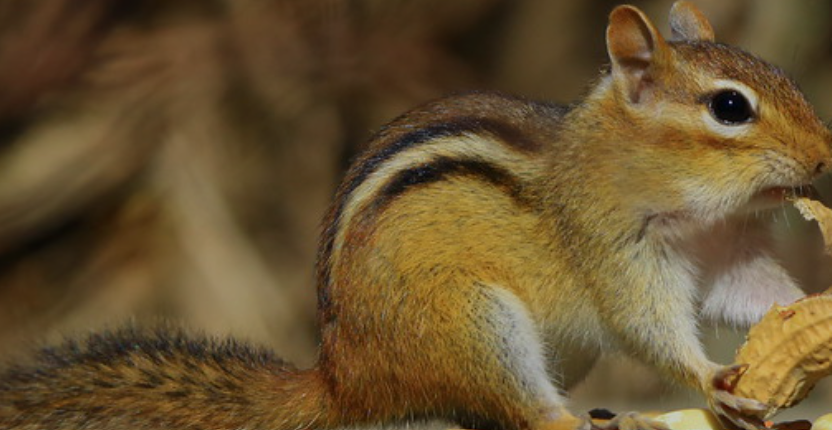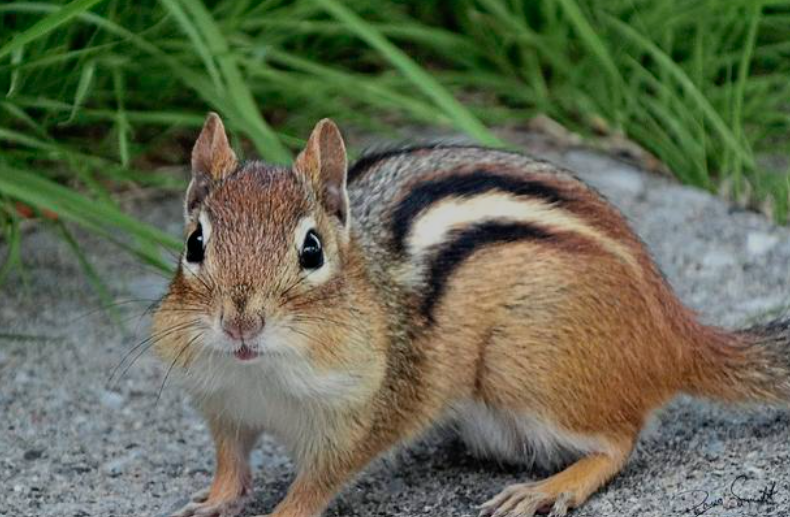
Chipmunks are small, striped rodents belonging to the squirrel family Sciuridae. They are known for their distinctive cheek pouches, which they use to carry food. With over 25 species, most are native to North America, though one species, the Siberian chipmunk, is found in Asia. These agile creatures typically measure 5 to 6 inches in body length, plus a bushy tail, and weigh around 1 to 5 ounces.
Chipmunks inhabit a variety of environments, from forests and woodlands to suburban gardens and rocky hillsides. They prefer areas with ample ground cover for protection against predators like hawks, foxes, and snakes. Many species dig extensive burrow systems underground, which serve as homes, food storage, and hibernation sites during winter months in colder climates.
Their diet is omnivorous but primarily consists of nuts, seeds, berries, insects, and fungi. Chipmunks are notorious foragers, gathering food in their expandable cheeks and hoarding it in caches for later use. This behavior helps them survive lean periods and contributes to seed dispersal in ecosystems.
Socially, chipmunks are mostly solitary except during mating seasons. They communicate through high-pitched chirps and tail flicks to warn of danger. Active during the day, they exhibit bursts of energy, scampering quickly and climbing trees with ease, though they are more ground-dwelling than tree squirrels.
Reproduction occurs once or twice a year, with litters of 2 to 8 young born after a gestation of about 30 days. The pups are blind and hairless at birth, relying on their mother in the burrow for the first few weeks. By two months, they venture out independently, reaching maturity in about a year.

Species of Chipmunks
Eastern Chipmunk (Tamias striatus)
The eastern chipmunk is the most familiar species in North America, often spotted darting across yards and forest floors. Recognized by its reddish-brown fur and distinct white and black stripes down the back, it is a solitary burrower that stores food underground. It thrives in woodlands, suburban areas, and gardens, where it gathers nuts, seeds, and berries to prepare for winter.
Least Chipmunk (Neotamias minimus)
This is the smallest chipmunk species, weighing only about an ounce. Found across western North America, it inhabits forests, grasslands, and even alpine tundra. Its adaptability allows it to survive in harsh conditions, and it is known for being quick and agile. Like other chipmunks, it has expandable cheek pouches for carrying food to its burrows.
Siberian Chipmunk (Eutamias sibiricus)
Native to Asia, particularly Siberia, Korea, and China, this is the only chipmunk species found outside North America. It has been introduced to parts of Europe, where it has established wild populations. It is slightly larger than the least chipmunk and hibernates during harsh winters, depending on large food caches for survival.
Lodgepole Chipmunk (Neotamias speciosus)
Named for its association with lodgepole pine forests in the western United States, this chipmunk has striking black and white stripes and reddish flanks. It lives at higher elevations, often in mountainous terrain. Its diet includes pine seeds, fungi, and insects, and it plays a role in spreading mycorrhizal fungi, which benefits forest ecosystems.
Yellow-Pine Chipmunk (Neotamias amoenus)
This species is common in western forests dominated by pine, fir, and mixed coniferous trees. It is smaller than some of its relatives but easily recognized by its bold striping and pale belly. The yellow-pine chipmunk is active mostly in the morning and late afternoon, spending much of its time collecting seeds and hiding them in caches.
Uinta Chipmunk (Neotamias umbrinus)
Found in the Rocky Mountains, particularly Utah, Wyoming, and Colorado, this chipmunk favors rocky slopes and coniferous forests. Its fur is rich brown with darker stripes and a paler underside. It hibernates through cold winters, relying on stored food, and is more arboreal than some other chipmunk species, often climbing trees in search of seeds.
Hopi Chipmunk (Neotamias rufus)
Inhabiting the deserts and rocky canyons of the southwestern United States, this small chipmunk has a reddish-brown coat that blends into its arid surroundings. It is a wary and fast-moving animal, feeding on seeds, fruits, and desert plants. Its burrows are often dug under shrubs or rocks to provide cover from predators.
Colorado Chipmunk (Neotamias quadrivittatus)
This species lives in the mountains of Colorado, New Mexico, and northern Arizona. It is larger than some of the smaller western chipmunks and has four distinct dark stripes running down its back. Adapted to rocky terrain and forest edges, it forages for nuts, berries, and insects while using rock crevices for shelter and protection.
Gray-Collared Chipmunk (Neotamias cinereicollis)
Found mainly in Arizona and New Mexico, the gray-collared chipmunk is named for the pale gray band around its neck and shoulders. It inhabits coniferous and mixed forests, often at higher elevations. Unlike many of its relatives, it spends more time climbing trees, where it forages for acorns, pine seeds, and berries.
Cliff Chipmunk (Neotamias dorsalis)
As its name suggests, this chipmunk favors rocky cliffs, canyons, and steep slopes across the southwestern United States. It is agile and sure-footed, making it well-adapted to its rugged environment. With a gray-brown coat and dark stripes along its back, it blends into the rocky surroundings, feeding on seeds, nuts, and desert plants.
Palmer’s Chipmunk (Neotamias palmeri)
This species is found only in the Spring Mountains of southern Nevada, making it one of the most geographically restricted chipmunks. Its fur is a mix of brown, gray, and buff, with prominent stripes. Palmer’s chipmunk is considered vulnerable due to its limited range, relying on pine forests for food and shelter.
Panamint Chipmunk (Neotamias panamintinus)
Native to the Panamint Range and nearby desert mountains of California and Nevada, this chipmunk thrives in dry, rocky habitats with scattered vegetation. It has bold dark stripes and a reddish tinge on its sides. Adapted to arid conditions, it feeds on seeds, juniper berries, and small insects while sheltering in crevices.
Sonoma Chipmunk (Neotamias sonomae)
Restricted to northern California, particularly in coastal forests, the Sonoma chipmunk is one of the least widespread species. Its dark stripes and rich brown fur make it distinctive, while its loud chattering calls set it apart from others. It forages both on the ground and in low shrubs, storing food in underground burrows.
Long-Eared Chipmunk (Neotamias quadrimaculatus)
Named for its relatively long ears, this chipmunk lives in the Sierra Nevada mountains of California. Its fur is reddish-brown with bold striping, and it is often found in dense forests at high elevations. Its large ears are thought to help with heat regulation and detecting predators.
Allen’s Chipmunk (Neotamias senex)
Endemic to northern California, Allen’s chipmunk inhabits coniferous forests and mountainous terrain. It has a darker coat compared to many other species and is more reclusive. Its populations are stable, but it has a more restricted range than widespread relatives like the eastern chipmunk.
Townsend’s Chipmunk (Neotamias townsendii)
Found in the Pacific Northwest, particularly Oregon and Washington, Townsend’s chipmunk is larger than many of its relatives. It prefers dense forests and shrubby areas, where it builds elaborate burrows. Its diet includes acorns, seeds, fungi, and fruits, and it plays a role in spreading seeds and spores throughout its environment.
California Chipmunk (Neotamias obscurus)
Native to southern California and Baja California, this species inhabits chaparral, coastal sage scrub, and rocky hillsides. Its fur is darker than many other chipmunks, often with a grayish-brown tone that helps it blend with dry, shrubby landscapes. It forages actively for seeds, berries, and insects, often storing food in hidden caches.
Yellow-Cheeked Chipmunk (Neotamias ochrogenys)
This species lives in the coastal forests of northern California. True to its name, it has a distinctive yellowish patch on its cheeks that makes it stand out. It thrives in moist forests with dense vegetation, where it feeds on seeds, fungi, and fruits. Its limited range makes it more vulnerable to habitat disturbance.
Durango Chipmunk (Neotamias durangae)
Found in the highlands of northern Mexico, particularly in Durango, this chipmunk inhabits pine and oak forests. It is a relatively poorly studied species, but like its relatives, it feeds on seeds, nuts, and insects. Its restricted range and dependence on forested habitats make it sensitive to deforestation.
Merriam’s Chipmunk (Neotamias merriami)
This chipmunk is native to central and southern California. It is characterized by its bold stripes and darker fur. Merriam’s chipmunk favors oak woodlands, chaparral, and rocky slopes. Known for its loud, sharp calls, it is one of the more vocal chipmunk species, often alerting others of nearby threats.
Siskiyou Chipmunk (Neotamias siskiyou)
Restricted to the Siskiyou Mountains of northern California and southern Oregon, this species prefers dense coniferous forests. Its fur is a mix of browns and grays, with distinct striping along the back. It is a shy, elusive animal, typically foraging in undergrowth for seeds, berries, and fungi.
Alpine Chipmunk (Neotamias alpinus)
This chipmunk is one of the few found at very high elevations, specifically in the Sierra Nevada of California. It inhabits alpine meadows, rocky slopes, and sparse forests. Adapted to harsh, cold environments, it is smaller than many lowland species and feeds on seeds, insects, and alpine vegetation.
Gray-Footed Chipmunk (Neotamias canipes)
Native to the mountains of New Mexico and Texas, this species gets its name from the gray coloration of its feet. It inhabits coniferous forests and is relatively uncommon. Its diet consists of acorns, seeds, and insects, and it uses underground burrows for shelter and food storage.
Buller’s Chipmunk (Neotamias bulleri)
Endemic to a small region in western Mexico, this rare species is one of the least studied chipmunks. It lives in pine-oak forests at moderate elevations. With a restricted range, it is vulnerable to habitat loss, though detailed information about its behavior and ecology remains limited.
Humboldt’s Chipmunk (Neotamias humboldtii)
Found in northern California, this species inhabits coastal forests and mountainous areas. It has dark, well-defined stripes and a reddish tinge on its fur. Humboldt’s chipmunk is active and vocal, often making sharp calls. It feeds on seeds, berries, fungi, and insects, and like many chipmunks, it plays an ecological role in seed dispersal.
Allen’s Big-Eared Chipmunk (Neotamias albigula)
Native to central California, this species is known for its relatively large ears and pale throat patch. It inhabits oak woodlands and mixed conifer forests, often in hilly or mountainous areas. Its big ears may help it detect predators and regulate body temperature. Like other chipmunks, it caches food in underground burrows.
San Bernardino Chipmunk (Neotamias speciosus frater)
Found in the San Bernardino Mountains of southern California, this chipmunk is a localized subspecies of the lodgepole chipmunk. It is adapted to high-altitude forests and rocky outcrops, where it feeds on pine seeds, acorns, and fungi. Its population is limited, making it more vulnerable to habitat changes.
Mount Graham Chipmunk (Neotamias dorsalis grahamensis)
This rare chipmunk is found only in the Pinaleño Mountains of Arizona. It is considered endangered because of its extremely small range. Living in mixed conifer forests, it depends on a stable habitat for survival. Conservation efforts have focused on protecting its forest environment from logging and wildfires.
Peñasco Least Chipmunk (Neotamias minimus atristriatus)
Once native to the Sacramento Mountains of New Mexico, this subspecies of the least chipmunk is considered possibly extinct, with no confirmed sightings in recent decades. It was one of the smallest chipmunks, adapted to high-altitude forests. Habitat loss and competition from other rodents are thought to have contributed to its decline.